Domenica Aguilera
Ann Reid Early Childhood Center
Naperville, Illinois
2012
The title of this project was “Making Tamales.” This project took place at the Ann Reid Early Childhood Center (ARECC) in Naperville, Illinois, where I have been teaching for two years. The children range in age from 3 to 5 years old, and they attend 2.5 hours in the morning or afternoon, four or five days a week. A total of 30 children participated in this project. The morning class is composed of nine boys and nine girls. The afternoon class, a “blended class,” has five girls and seven boys.
Both classes are bilingual. The primary language spoken in the class is Spanish. The children receive 20 minutes of English instruction every day.
Our project began on December 12 and ended December 21. Completing the project took us about two weeks. My two assistant teachers and I facilitated the project, and some parents also assisted.
Phase 1: Beginning the Project
The project began after the children and the teachers had many conversations about the food we eat during the winter holidays. The morning class started our project by sharing and listening to each other’s experiences about winter holidays. Some children said that their parents make tamales on Christmas Eve, and other children said that in Mexico their grandparents make tamales. After our conversation, I showed the children a video of my mother making tamales. After watching the video, many children said their parents do not let them help make tamales at home because tamales are hard to make and the process includes too many steps. One child suggested that it would be a good idea to make tamales in the classroom.
Later that day, I explained to the afternoon class that some friends in the morning class wanted to make tamales. I asked if they had seen or eaten tamales before. The children immediately responded by saying that they like to eat tamales. Children in the afternoon class also said their parents make tamales for Christmas Eve. The children were very interested in the topic, so I asked them if they would like to make tamales in the classroom. They said “yes,” so I also showed them the video of my mother making tamales.
Children from both classes shared their experiences and asked questions about tamales:
- How do we make them?
- What do we need?
- Do we cook them?
- What do we put inside?
- How do we fold them?
- What do we put on the corn husk?
- How do we eat them?
The questions were written on the smart board during a group meeting. I combined questions from the morning and afternoon classes. After our group meetings, the children in both classes were very enthusiastic about making tamales in the classroom. They wanted to investigate how to make them.
Phase 2: Developing the Project
Day 1: After writing the children’s questions on the smart board, the teachers helped the children identify key vocabulary words, which came from the list of ingredients or cookware needed to make the tamales.
- Corn husk
- Cooked chicken
- Salsa verde
- Premixed corn masa
- Steamer
The vocabulary words were the same for both classes. These vocabulary words were sent to parents along with other information about our planning and the process of making tamales. Also, parents were invited to come to the classroom to participate and help with the project. See PDF of the newsletter sent home to parents with information about the tamale project.
- Parent Newsletter (PDF)
Day 2: The teachers and children reviewed the vocabulary words, and I read aloud to them from the picture book Growing Up With Tamales/Los Tamales de Ana. This 2008 book was written by Gwendolyn Zepeda and illustrated by April Ward. It was translated by Gabriela Baeza Ventura and is published by Piñata Books (see figure 1).
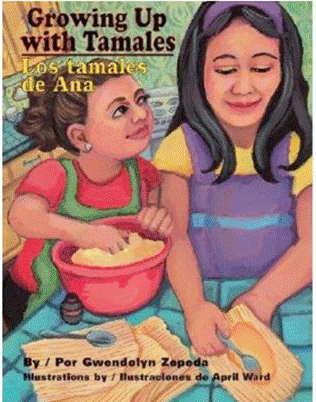
I chose this book because as she grows up, the main character, Anita, helps make tamales every year, and each year she participates in one more step in the process. For example when she is 6 years old, she only helps mix the corn masa. When she is 8 years old, she helps prepare the chicken. This story goes through all the steps in the process of making tamales in a way that children can connect with their personal lives.
After finishing the book, the teachers and children reviewed the steps of making tamales. (See figures 2–5 for the steps necessary for making tamales. Note that we did not include a step for mixing the dry masa with liquid because we were using a prepared mix from the grocery store.) We also made a list of the things we were going to need to make the tamales.
Day 3: The teachers helped all of the children make “sequencing crowns” showing the four steps in making the tamales that I had gone over with them the previous day. Each teacher provided support for a small group of children. On strips of construction paper, each child glued four pictures that represent the sequence for making tamales. The pictures were printed in random order. The children cut the pictures and glued them in order on the paper strip (see Figures 6 & 7). We found that some children needed more support than others. The children took the crowns home so they could show their parents and review the sequence with them.
Day 4: The next day, I brought in uncooked chicken breasts (two for each class). I showed them to the children and asked if the chicken was ready to be spread on the premixed corn masa. After some discussion, the children decided that the chicken needed to be cooked in a pan like those they have at home. We walked to the school kitchen to see if we could find a pan (see Figure 8). Then, I boiled the chicken. Both the morning and afternoon classes participated in this process.

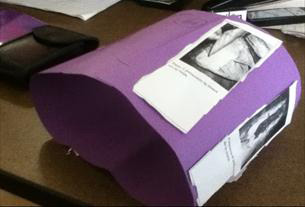
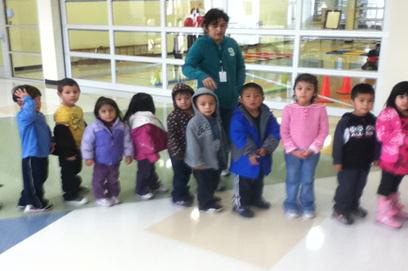
Day 5: The next day, the cooked chicken was ready to be shredded. Parents were invited to assist in this work. The children and adults sat at tables in the classroom. The children and their parents shredded the chicken. The children took turns adding salsa verde, or green sauce, to the chicken (a total of about 2 cups). All the children had a chance to participate (see Figures 9a & 9b). We took the chicken with the salsa to the kitchen and cooked them together in a stir fry pan.
Day 6: The following day, everyone was ready to make the tamales. First, I demonstrated to the children the steps for assembling the tamales and reviewed their sequencing crowns. The children then assembled the tamales (see Figures 10a & 10b.) Once the tamales were assembled, I explained to them that tamales take a lot of time to cook. I volunteered to take the tamales home with me to steam them.
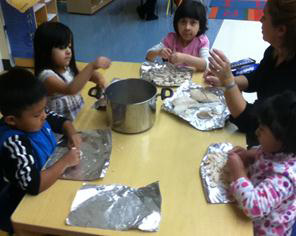
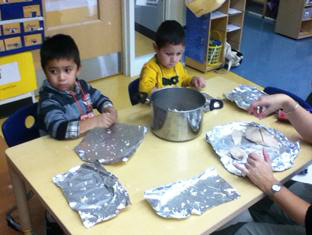
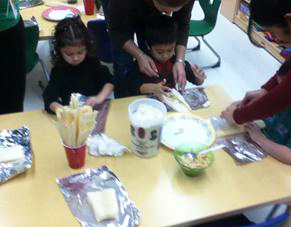
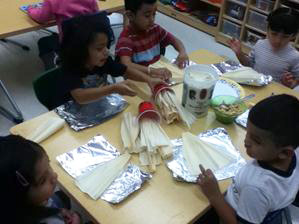
Phase 3: Concluding the Project
The week before we started the preparation for the tamales, parents were notified of the event and the preparation process. A sequence worksheet about how to make tamales was sent home to the parents. Also, in the weekly “Newsweek” letter, parents were invited to come to the classroom to help and participate.
Day 7: The culminating event for this project was eating the tamales with some of the parents who joined us. The children and adults unwrapped the cooked tamales and ate them. Parents told us they were very happy to see that their children had worked hard to make the tamales.
My main expectation during this project was for children to work cooperatively and to enjoy and embrace their home and community cultures. With support from teachers and parents, the children followed directions and were able to make their own tamales. Almost all the children said the tamales were very good. Some even asked for more.
During the tamale project, the children gained some skills that will help them to be successful at school. First, making the tamales required the children to work cooperatively. They helped each other fold their tamales. Waiting for a turn to scoop the masa onto the corn husks also gave them practice with turn-taking and being patient. The children also had opportunities to make connections to conventions of print. For example, when we were reading the book Los tamales de Ana, children identified where to start reading and knew that reading progresses from left to right and top to bottom. The children also responded to questions before, during, and after reading and were able to express their ideas effectively. They also connected the book’s story with their personal experiences by sharing their memory stories about tamales. The children also applied mathematical skills to tasks such as counting the corn husks, working on the sequence for assembling tamales, and making predictions. Most importantly, the children had the opportunity to embrace and share their cultures with others in the school environment.
Teacher Reflection
Working on this project confirmed my understanding of how culture is part of a child’s life. When children have the opportunity to share knowledge about their cultures with other children, they feel good about and proud of themselves. I believe that when children feel pride in who they are, they do better at school because they are more confident and participate more in school activities. In fact, this project embraced culture and traditions in a way that was very meaningful to and fun for the children.
As a teacher, I realized that children are capable of learning a lot if teachers scaffold classroom experiences by providing support as needed based on knowledge of what they already understand. When teachers connect children’s personal experiences with school experiences, children may be more open to the opportunities for new learning in the classroom. In addition, children are more likely to be productive, successful, and curious when teachers take the children’s interests into consideration when planning the curriculum.
I believe that we all—teachers, children, and parents—benefited from this project because we felt we were part of a family that learned to share and had fun together. We also learned that we are all united and yet different in special ways.





